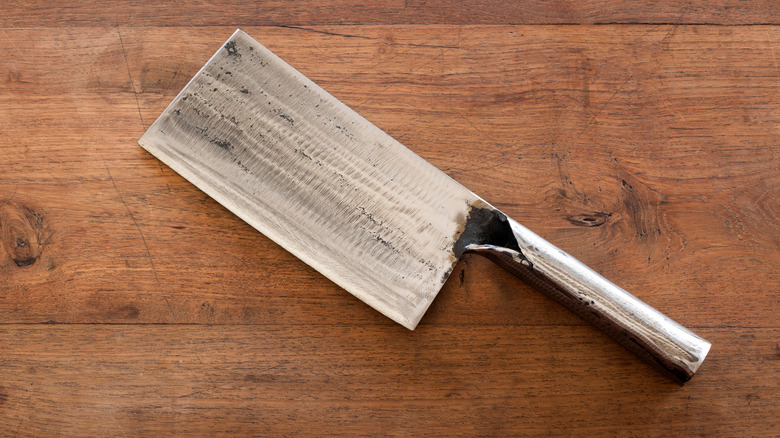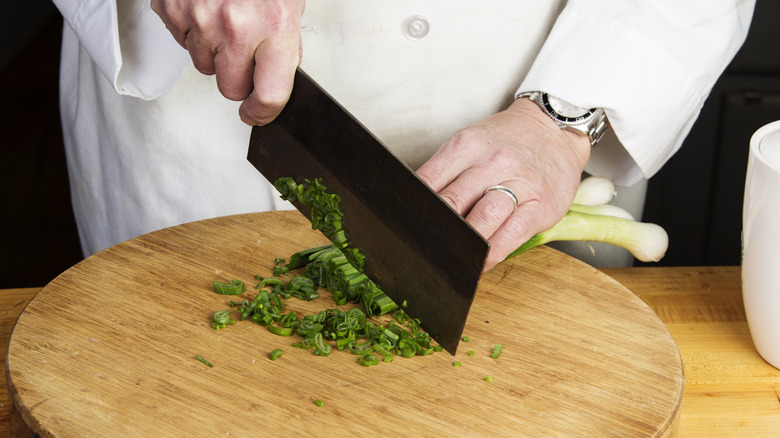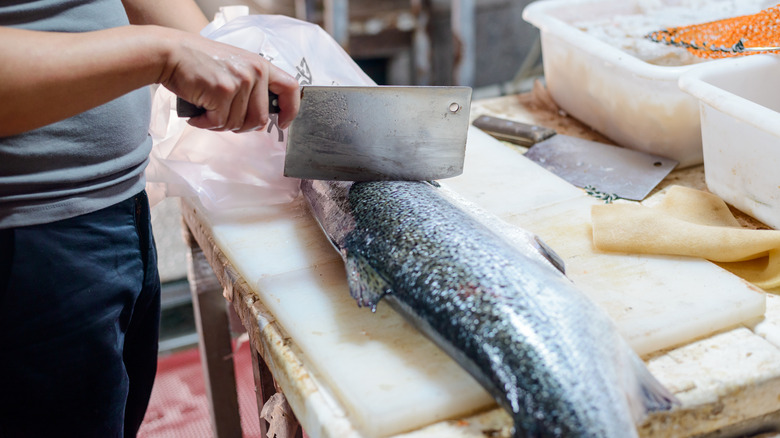What Is A Chinese Cleaver And What Is It Best Used For?
There are a lot of different kitchen knives that are each best suited for various tasks. There's the classic, versatile chef's knife that can handle pretty much anything, a paring knife that's best for mincing, a boning knife that's used to remove bones from meat, a bread knife that's great for slicing loaves of bread or tomatoes, and many more (via Auguste Escoffier School of Culinary Arts). It's important to have the proper knife for the task because using a paring knife, for example, to cut a loaf of bread would be a lot more difficult compared to if you had a proper bread knife to slice bread.
Conveniently, there are some multipurpose, versatile knives available that can handle many tasks. For example, the Chinese cleaver is similar to a chef's knife in that it can be used for all sorts of tasks, and many Asian families only use one single cleaver for all their cutting tasks, per The New York Times. Some Chinese cleavers are even passed down from generation to generation within a family. So, what exactly is a Chinese cleaver, and what applications is it best used in? Here's what you need to know.
Chinese cleavers are unique and versatile
Chinese cleavers are set apart from other knives by having a much larger blade that's shaped like a rectangle and doesn't come to a point like a chef's knife (via The New York Times). Chinese cleavers also often have wooden handles and are a lot heavier than most other knives, with most of their weight concentrated on the front area where the blade is. The earliest form of a Chinese cleaver can be traced back to about 800,000 years ago and looked like an arrowhead, according to R.A. Knife. It's referred to as a Lantian stone knife and was used to slice plant roots and animal flesh. The appearance of Chinese cleavers then changed around 4,500 years ago to have a more pronounced V-shape blade and a handle. By 1297 A.D., Chinese cleavers were made to look like they are today.
Chinese cleavers can weigh anywhere from 300 grams (0.66 pounds) to 900 grams (1.98 pounds) and can measure 180 millimeters (7.09 inches) to 240 millimeters (9.45 inches), per Japanese Knives Guide. There are essentially three types of Chinese cleavers. Caidao is ideal for lighter work and has a thinner blade, while a gudao is great for heavy-duty work and has a thicker blade (via The New York Times). A chopper is a combination of a caidao and gudao and has a blade with a thin front and a thicker back.
Chinese cleavers can handle a lot of different cutting tasks
Chinese cleavers can be used for a lot of cutting tasks in the kitchen, and each part of the versatile knife has a purpose. Because the top of the blade, or the spine, weighs more than the bottom of the blade, the Chinese cleaver provides enough force to slice through pretty much everything, per R.A. Knife. It can be used for finer, more precise cutting jobs such as julienning or scoring vegetables and can then be used to pound meat (via Britannica). For example, a Chinese cleaver can be used to remove scales from a fish, cut the fish into filets, and then thinly slice scallions or other vegetables, according to The New York Times.
The wide blade can also be used to transport food from a cutting board to a cooking vessel instead of using something like a bench scraper. It can even be used for cutting tasks outside of the kitchen, such as chopping and gathering firewood for cooking and whittling and carving wood for chopsticks. As mentioned before, Chinese cleavers are great multipurpose knives, but they can't handle all applications, such as slicing bread.


